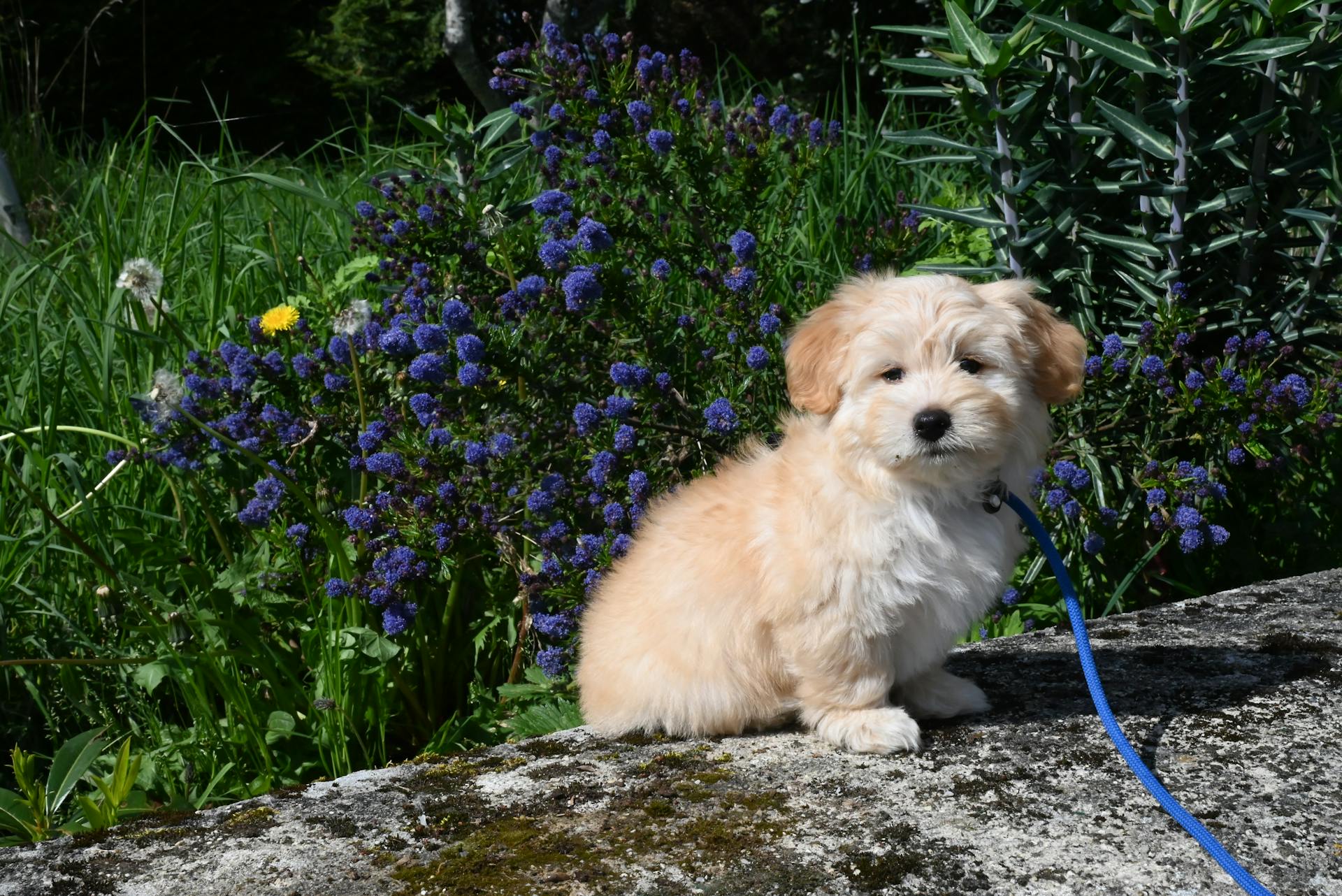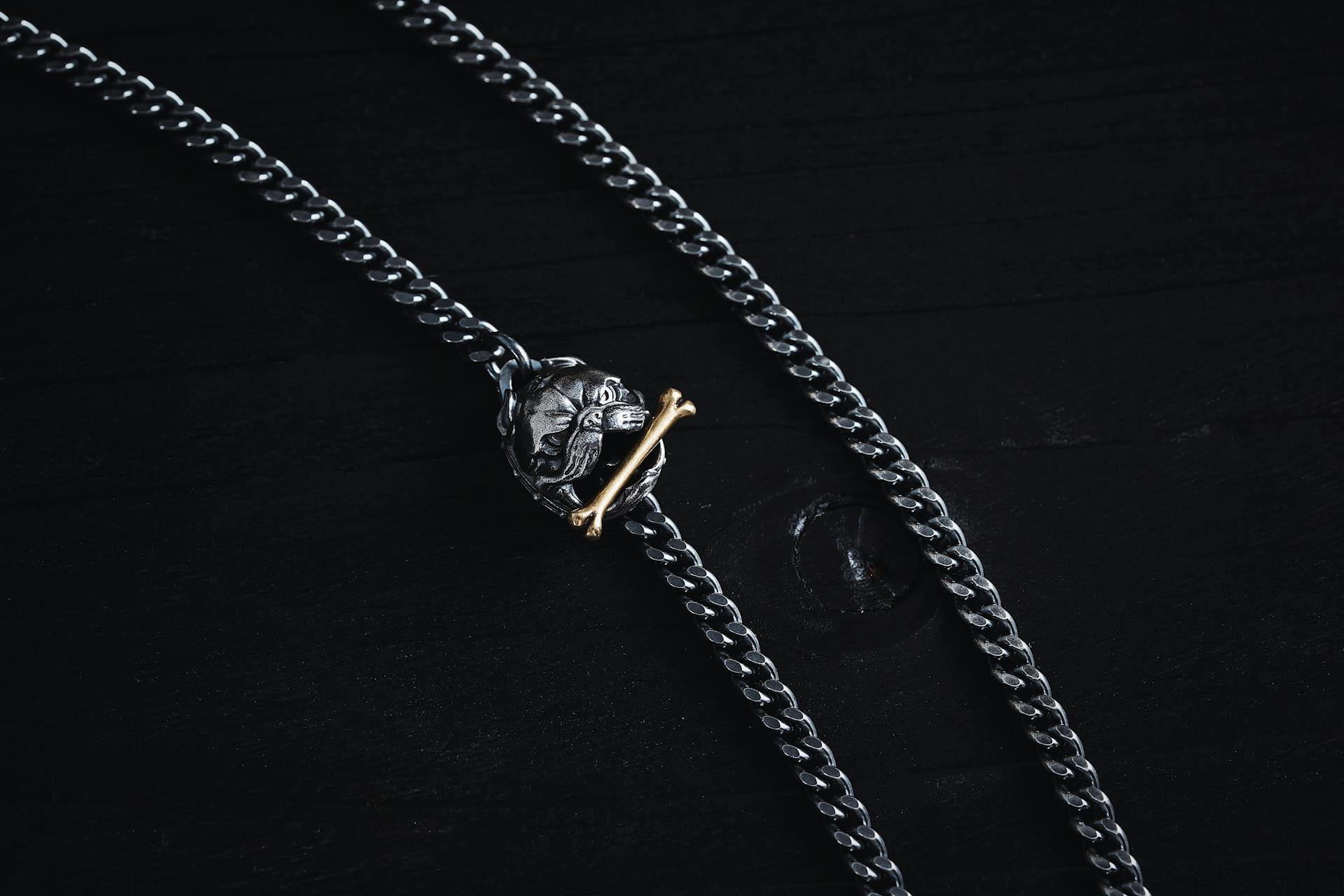
The Parti Havanese dog breed is a unique and charming companion. They are a variation of the Havanese breed, known for their silky coats and playful personalities.
One of the most distinctive features of the Parti Havanese is their coat coloration, which is a mix of white and colored patches. This coloration is the result of a genetic variation that affects the production of melanin in their fur.
The Parti Havanese is a relatively small breed, weighing between 7-13 pounds and standing between 8.5-11.5 inches tall. They are a popular breed due to their affectionate and outgoing nature.
Origin & History
The Havanese breed has a rich history that spans centuries. They originated in Cuba in the 1600s, courtesy of Spanish colonizers or Italian seafarers.
These lively dogs quickly gained popularity among the island's social elite, who favored them over working dogs. The Havanese breed was refined with Poodle crosses, which helped them develop into the dogs they are today.
Their name is a nod to their beloved status in Havana, where they were particularly popular. Havanese dogs arrived in the United States after the Cuban Revolution.
Temperament & Intelligence
Havanese dogs are incredibly smart and usually easy to train. They develop deep bonds with their people and frequently follow their favorites around.
They're generally pretty good watchdogs who're happy to keep an eye on their family. Excessive barking can be a problem with Havanese dogs, but you can reduce it with training.
Havanese dogs usually fit right in with families, particularly when they have solid early socialization training that helps them learn how to behave in different situations, such as around kids.
They're excellent companions for children due to their lively nature and comical antics, but they should be supervised when interacting with infants.
Take a look at this: When Should I Breed My Female Dog
Grooming and Health
Grooming is a crucial part of owning a Parti Havanese, and it's not just about making them look cute. Regular brushing is a must to prevent mats and tangles, but most Havanese dogs actually enjoy being brushed, making it a great bonding activity.
To keep their coats looking their best, regular trips to the groomer for trims are a must. Short, adorable puppy cuts are popular options, and some owners even style their pets with "corded" cuts.
Their facial hair requires special trimming to ensure it stays out of their eyes, and removing wax and debris can help prevent ear infections. Regular nail trims and dental hygiene are also essential, as Havanese dogs are vulnerable to dental disease.
Here are some common health conditions to be aware of in Parti Havanese dogs:
- Patellar Luxation
- Dental Disease
- Eye Conditions
- Chondrodysplasia
Additionally, they may be prone to Legg-Calve-Perthes disease and progressive retinal atrophy. Regular eye and ear checks can help catch any potential issues early on.
Grooming
Grooming is a crucial part of Havanese dog care, and it's essential to establish a daily routine to keep their coats looking their best.
Daily brushing is a must to prevent mats and tangles, and most Havanese dogs actually enjoy the process, making it a great bonding activity.
Regular trips to the groomer can keep your Havanese looking good and make maintenance at home a breeze. Short puppy cuts are a popular option, and some owners like to style their pets with "corded" cuts.
Their facial hair requires special trimming to ensure it doesn't get in their eyes. Regular eye checks and cleaning are also a must.
Nail trims are essential for all dogs, and Havanese are no exception. Their teeth need regular brushing to prevent dental disease, which is a significant concern for this breed.
Health and Conditions
Havanese dogs are generally a healthy breed, but like any other breed, they can be prone to certain health issues. One common issue is patellar luxation, where the kneecap slips out of place, which can cause pain and discomfort for your furry friend.
Dental disease is also a concern for Havanese dogs, as it can lead to tooth loss and other oral health problems. Regular brushing and dental check-ups can help prevent this issue.
Eye conditions are relatively common in Havanese dogs, which can range from mild to severe. Chondrodysplasia, a condition that affects the development of joints, can also be a problem for this breed.
Broaden your view: Havanese Health Issues
Legg-Calve-Perthes disease, a condition that affects the hip joint, can cause arthritis and mobility issues in Havanese dogs. Progressive retinal atrophy, a degenerative eye disorder, can also affect this breed.
Here are some common health issues to watch out for in Havanese dogs:
- Patellar Luxation
- Dental Disease
- Eye Conditions
- Chondrodysplasia
- Legg-Calve-Perthes Disease
- Progressive Retinal Atrophy
Colors and Patterns
The Parti Havanese is known for its unique and varied coat colors and patterns.
Parti-color Havanese dogs have less white fur than those with white markings. Their coat color is characterized by spots of hair that are colored differently from the cluster of hair they appear in. These spots are often darkly colored, such as brown or black.
The distribution of patterns in Parti Havanese dogs can be unpredictable, making it challenging to determine whether or not they have the parti belton coloration. This is due to the breed's long hair, which can sometimes make it difficult to see the underlying coat color.
Parti Belton Havanese dogs sport a playful coloration pattern characterized by spots of differently colored hair amidst clusters of lighter fur. This pattern can add intrigue to their appearance, but it can also be challenging to identify due to their long hair.
If this caught your attention, see: Havanese Color Change
Some Parti Havanese dogs may feature tan markings on their face, including a mask shape around the mouth and patches over the eyes. These markings can add a touch of sophistication to their appearance.
Tricolor Havanese dogs offer a symphony of colors on their coat, including black, white, and brown. They may also feature blue and silver colors, making each dog a unique masterpiece.
The Irish pied coloration presents a distinctive blend of white fur covering over half of the Havanese's body. This can lead to confusion with other colors, but it's actually a unique and beautiful pattern.
Parti-color Havanese dogs showcase a mosaic of colors that captivates the eye and highlights their individuality. With less white fur and unpredictable pattern distribution, each Parti-color Havanese is truly one-of-a-kind.
See what others are reading: White Hungarian Puli Dog
Colors
Parti Havanese dogs are often mistaken for Havanese dogs with white markings, but there are notable differences between the two. Parti-color Havanese have less white fur than those with white markings.
See what others are reading: White Komondor Puppy
The distribution of patterns in parti-color Havanese is more unpredictable than in Havanese dogs with white markings. This means you may not be able to anticipate where the colors will be on a parti-color Havanese.
Tan markings on Havanese dogs, though covering a small area, exude subtle elegance, often appearing in a mask shape on the face, including the mouth and patches over the eyes. Some Havanese may also feature tan patches on their paws or neck, adding a touch of sophistication to their appearance.
Parti-color Havanese can have a variety of color combinations, including tan and white, which is a popular and elegant combination. This combination adds a touch of sophistication to the dog's appearance.
Tricolor Havanese dogs, adorned with three colors on their coat such as black, white, and brown, offer a symphony of colors that captivates the eye. With variations that may include blue and silver, tricolor Havanese dogs showcase a unique blend of hues, making each dog a masterpiece.
The chocolate and white Havanese dog is effortlessly one of the most popular color variations of the breed. This variation typically has a consistent marking distribution, with most of the coat being dark brown and white spots covering the dog's face, paws, neck, and chest.
Explore further: Havanese Dog Colors
Red and white Havanese puppies are wrapped in a red coat adorned with white markings, which can be either predictable or random. In some cases, the markings may be spread entirely randomly, making each dog unique.
Silver markings on Havanese dogs, though subtle, add an air of elegance with their light, shiny appearance resembling shades of gray. These markings, covering small areas such as the face, paws, and neck, contribute to the dog's distinctive allure.
The silver and white Havanese, with its eye-catching distribution of colors, boasts a salt-and-pepper appearance that captures attention. Whether predominantly silver-gray or speckled with white, these Havanese dogs showcase a unique blend of colors that adds depth and character to their coat.
You might enjoy: Mudi Dog Colors
Owning a Parti Havanese
A Parti Havanese is a beautiful variation of the Havanese breed, with a coat that's more than 50% white and patches or spotting in another color.
The Parti-color marking is one of the many possible markings a Havanese can have, and it's characterized by a predominantly white coat with patches of another color.
If you're considering bringing a Parti Havanese into your family, be aware that their coat requires regular grooming to prevent matting and tangling, especially where the white and colored patches meet.
Here are some common markings you might see on a Parti Havanese:
- White markings
- Cream markings
- Silver markings
- Tan points
These markings can add to the dog's unique charm, but it's essential to remember that every Parti Havanese is an individual, and their personality and temperament are just as important as their appearance.
Owning a Dog
Owning a dog requires a significant commitment of time and resources.
You'll need to consider the costs associated with owning a dog, including food, vet bills, and supplies.
Havanese dogs make remarkable pets, but before you adopt one, you can read more about what it takes to care for them.
Regular grooming is essential for Havanese dogs, as their coats require regular brushing and maintenance.
They are intelligent and active, so they need plenty of exercise and mental stimulation to prevent boredom and destructive behavior.
Havanese dogs are known for their gentle and affectionate nature, making them a great fit for families with children.
What Can You Have?
Owning a Parti Havanese is a treat, and one of the best things about these adorable dogs is their unique coat patterns.
You can have a Parti Havanese with white markings, which can appear in various locations on the dog's body.
Cream markings are also possible, adding a warm and inviting touch to your Havanese's coat.
Silver markings are another option, giving your Havanese a sleek and sophisticated look.
Silver points can also be present, adding a touch of elegance to your dog's coat.
Parti-color is a beautiful pattern where more than 50% of the coat is white, with patches or spotting in another color.
Tan points are a lovely addition to a Havanese's coat, adding a warm and natural touch.
Irish pied and Parti belton are also possible coat patterns, where two colors are present and more than 50% of the coat is in a color that isn't white.
Frequently Asked Questions
What is the difference between parti and pied?
The key difference between parti and pied is the pattern and distribution of colors on a dog's coat. Parti dogs have 50% or more white, while pied dogs have 50% or more color, with distinct patterns and markings.
What two breeds make a Havanese?
The Havanese breed is believed to be a cross between the Blanquito and the poodle. This unique heritage makes the Havanese a distinct and charming companion dog.
Featured Images: pexels.com


